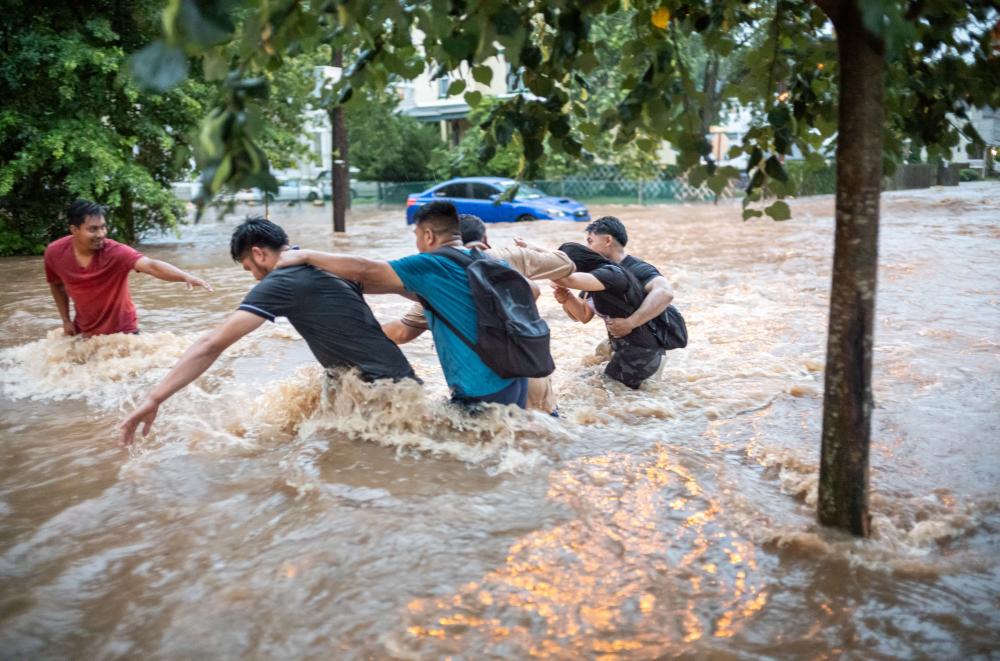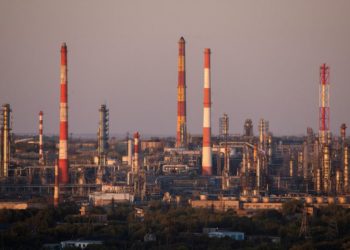Monday night’s downpour was one of the most intense rainstorms in New York City history, the kind of storm that’s now happening much more often due to climate warming.
More than 2in of rain fell in New York City’s Central Park in the 7pm hour on Monday evening, part of a regional downpour that filled the city’s highways and subway tunnels and prompted several water rescues.
Rains were even more intense elsewhere in the region. More than 2in of rain fell in just 30 minutes in Brewster, New York, in the Hudson Valley.
In Union County, New Jersey, more than 6in of rain fell in little more than an hour and at least two people died as the vehicle they were traveling in was washed off the road. Phil Murphy, the New Jersey governor, declared a state of emergency due to the heavy rainfall and advised people to avoid unnecessary travel.
“Jersey is FLOODING. I’ve never ever seen the highways flood. This is crazy. The climate crisis is literally outside right now,” wrote one person from New Jersey on social media.
The rains came as the result of what the National Weather Service called a “quickly evolving scenario” as a slow-moving cold front began interacting with extremely moisture-laden air drawn westward from the warmer-than-normal Atlantic Ocean. The NWS had given the hardest-hit regions, including New York City, advanced notice with numerous flood warnings.
Intense periods of rain like the one on Monday have been causing increasing problems throughout the region as the climate changes. NYC now endures one extra day of heavy rain each year, on average, compared with the late 19th century.
A widely shared video appeared to show floodwaters erupting from the sewer system like a geyser at the 28th Street station in midtown Manhattan, pouring into a stalled subway car filled with people.
“What happened last night is something that is a reality for our system,” said Janno Lieber, CEO of the Metropolitan Transportation Authority, in an interview with a New York City television station. “The storm water system gets backed up and gets overwhelmed and tunnels into the stations.”
While the city’s subway systems are designed to drain a maximum of 1.75in of rainwater per hour, the 2.07in of rain was the sixth-highest hourly total since New York City weather records began in 1869 and the most intense rainstorm since the remnants of Hurricane Ida in September 2021. Ida caused 14 deaths in the north-east, most of whom died in flooded basement apartments.
A rainstorm exceeding the subway design limit had never been recorded before 1991 but has happened six times since then, including Monday’s rains. A study published last year showed rainstorms like the one during Ida are now between four and 52 times more likely due to the climate crisis. A separate study in 2021 found a similar result and also found that rainstorms in the north-east region are the fastest increasing in the nation.
Over the past three years, Eric Adams, the New York City mayor, has allocated more than $1bn to stormwater improvements in the city. Still, that amount is far lower than what experts say is needed to update the city’s ageing infrastructure for the current climate reality, not even what is expected in the future.
“We have an infrastructure that was designed for an environment we no longer live in,” Rohit Aggarwala, New York City’s chief climate officer, told the New York Times.
In addition to the rising impact of freshwater floods, the region also has to deal with a simultaneously increasing threat from the expanding Atlantic Ocean. The city’s flood resiliency plan anticipates it will need $46bn to protect against a one-in-100-year storm.
The flooding in New Jersey comes as the state is contemplating sweeping changes to expand its flood zones and require new properties to be elevated if they are built in areas likely to flood at least once in the next 100 years.
Related: Are we heading for ‘managed retreat’? Everything you need to know about floods
Research published this month shows wintertime storms in the north-east are also getting more destructive as sea levels rise and the receding Arctic sea ice helps morph weather patterns into more exaggerated and powerful iterations.
The most destructive recent example of this kind of storm was Superstorm Sandy, a hybrid nor’easter and hurricane that filled New York City’s subway tunnels with saltwater and caused $19bn of damage in the city.
As climate warming continues, it’s likely that flooding is going to keep getting worse. Rainfall intensity in the north-east could increase by a further 52% by the end of the century, according to a recent study.
The heavy rains in north-east US come as several other parts of the country, including central Texas, endure one of the most intense flood seasons in recent memory. According to statistics compiled by meteorologist Michael Lowry, the NWS has issued more flood warnings this year than in any other year since that type of warning began in 1986. On Monday alone, 96 flood warnings were issued – the most for any July day on record.
Eric Holthaus is a meteorologist and climate journalist based in Minnesota
The post How climate crisis makes rainstorms that flooded New York more common appeared first on The Guardian.



